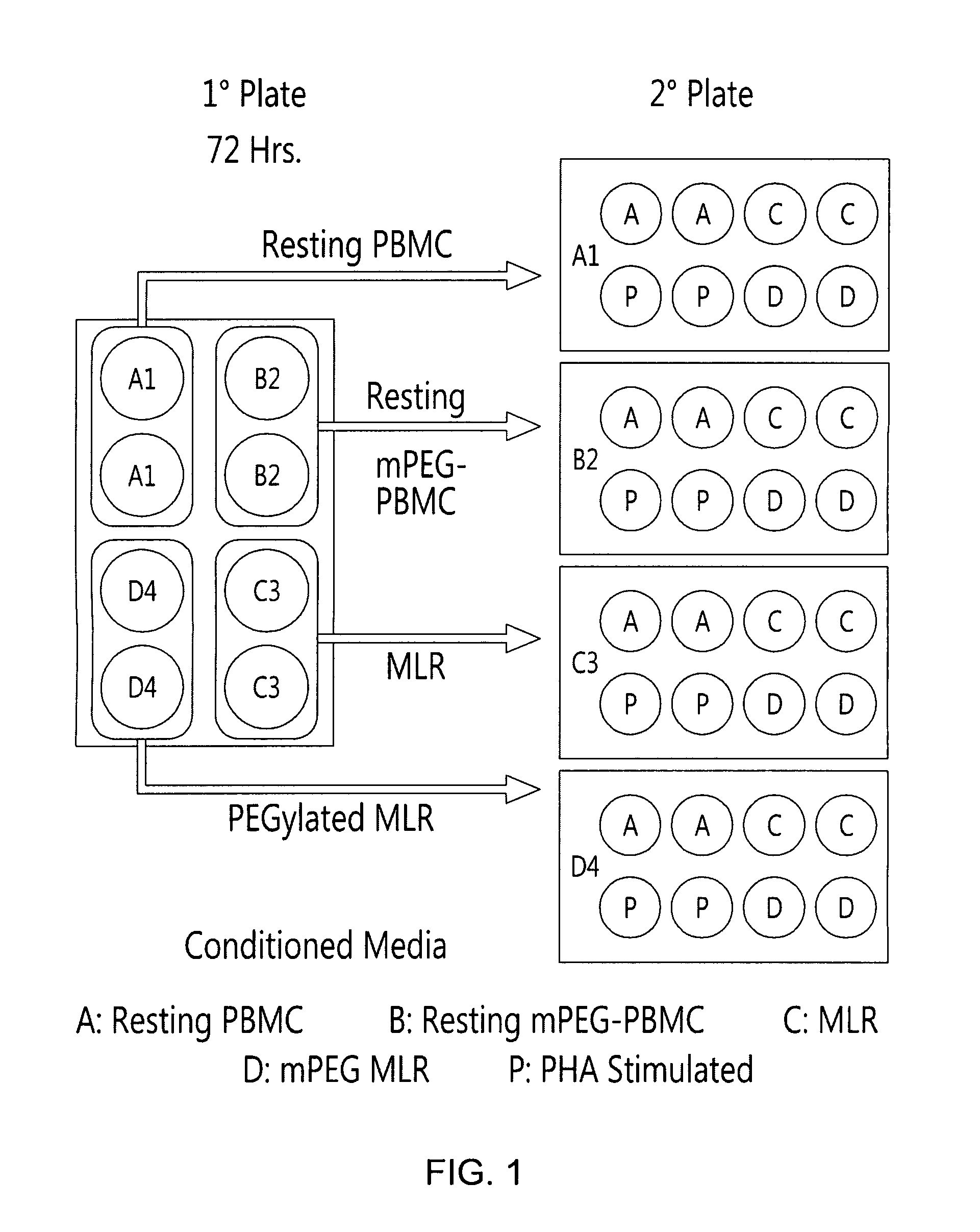Method for Inducing Immune Tolerance Using Viable Polymer-Modified Allogeneic Leukocytes
a technology of allogeneic leukocytes and polymer-modified allogeneic cells, which is applied in the direction of blood/immune system cells, biocide, pharmaceutical non-active ingredients, etc., can solve the problems of significant clinical problems such as acute and chronic rejection of donor tissues and organs, and achieve the effect of increasing the ratio of regulatory t, provoking anergy or tolerance, and increasing treg levels
- Summary
- Abstract
- Description
- Claims
- Application Information
AI Technical Summary
Benefits of technology
Problems solved by technology
Method used
Image
Examples
example i
Material and Methods
[0089]Human PBMC and dendritic cell preparation. Human whole blood was collected in heparinized vacutainer blood collection tubes (BD, Franklin Lakes, N.J.) from healthy volunteer donors following informed consent. PBMC were isolated from diluted whole blood using FicollePaque PREMIUM™ (GE Healthcare Bio-Sciences Corp, Piscataway, N.J.) as per the product instructions. The PBMC layer was washed twice with 1× Hank's Balanced Salt Solution (HBSS; without CaCl2 and MgSO4; Invitrogen by Life Technologies, Carlsbad, Calif.) and resuspended in the appropriate media as needed for mixed lymphocyte reactions and flow cytometric analysis of Treg and Th17 phenotypes. Dendritic cells (DC) were prepared from isolated PBMC as described by O'Neill and Bhardwaj (O'Neill et al., 2005). Briefly, freshly isolated PBMC were overlaid on Petri dishes for 3 h in AIM V serum free culture medium (Invitrogen, Carlsbad, Calif.). Non-adherent cells were gently washed off the plate. The adh...
example ii
In Vitro and In Vivo Immunomodulation
[0098]The material and methods used in this example are provided in Example I.
[0099]To determine the effects of polymer grafting on the immune response, initial in vitro experiments examined the cytokine burst characterizing control and polymer modified MLR. The polymer-modification of human PBMC resulted in significant changes in the cytokine profile of the conditioned media obtained from the 1° MLR plate (FIGS. 1 and 2). As shown in FIG. 2, control MLRs yielded elevated concentrations of IL-2, IFN-γ, IL-17A, TNF-α and IL-6 relative to resting unmodified or PEGylated PBMC. In contrast to the control MLR, the mPEG-MLR (one donor population PEGylated with 1 mM 5 kDa SVA-mPEG) resulted in the virtually complete inhibition (p<0.001) of secretion for the proinflammatory cytokines examined. However, IL-10 was preferentially elevated in the mPEG-MLR. In the conditioned media, IL-10 levels were 2.01±1.26, 8.90±2.10, 1.69±0.64 and 1.33±0.73 ng / ml for th...
example iii
In Vivo Immunomodulation in NOD Mice
[0115]In the NOD mice, autoimmune destruction of the pancreatic islets occurs within approximately 16 weeks and was confirmed with elevated blood glucose measures. The lymphocytes from pre-diabetic and diabetic animals has been obtained from the spleen, the brachial lymph node and the pancreatic lymph node. These lymphocytes have been submitted to flow cytometry using anti-IL-17A (PE) and anti-FoxP3 (Alexa 697) antibodies. As shown in FIG. 11, significant changes in the levels of Th17 and Treg lymphocytes are noted in the spleen, brachial lymph node and pancreatic lymph nodes upon conversion of NOD mice from non-diabetic to diabetic state. These changes are characterized by dramatically increased Th17 (top numbers in each panels) and significantly decreased Treg (lower numbers in each panels) lymphocytes. Tregs: *, p<0.001 from non-diabetic NOD mice. Th17: ** p<0.001 from non-diabetic NOD mice.
[0116]The NOD mice (8 to 10 week-old) have been treate...
PUM
| Property | Measurement | Unit |
|---|---|---|
| Immunogenicity | aaaaa | aaaaa |
| Biocompatibility | aaaaa | aaaaa |
Abstract
Description
Claims
Application Information
 Login to View More
Login to View More - R&D
- Intellectual Property
- Life Sciences
- Materials
- Tech Scout
- Unparalleled Data Quality
- Higher Quality Content
- 60% Fewer Hallucinations
Browse by: Latest US Patents, China's latest patents, Technical Efficacy Thesaurus, Application Domain, Technology Topic, Popular Technical Reports.
© 2025 PatSnap. All rights reserved.Legal|Privacy policy|Modern Slavery Act Transparency Statement|Sitemap|About US| Contact US: help@patsnap.com



